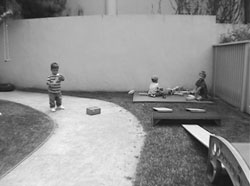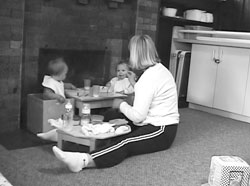
(See related pages)
OBSERVATION AND REFLECTION Directions: Watch the clip from beginning to end. It's a very short segment. Then think back to what you observed. Write down as much as you remember, giving as many details as possible. When you finish writing, watch the video again, go back, and add more details. Change what you wrote (if needed). Then write one sentence at the bottom of your observations saying what you learned by doing it. You can record your observation in the space provided in the Caregiver's Companion that accompanies your textbook.
RUNNING RECORD OBSERVATION Directions: The idea of a running record observation is to take quick notes on what you are seeing, including as many details as possible, and then to write up your observation in the sequence in which it unfolded. Use complete sentences and paragraphs. What you write should be objective: only what you saw. Don't take short cuts like "the child played with the ball and tube." Describe the child's actions in the most minute detail possible, and include such things as body posture and movement, facial expressions, and other details that you can actually see. You can record your observation in the space provided in the Caregiver's Companion that accompanies your textbook.
ANECDOTAL RECORDS Directions: Watch this clip without writing anything down. Now give the child a name, and then write down as much as you can remember about the child. Did anything particularly stand out in your memory? You can record your observations in the space provided in the Caregiver's Companion that accompanies your textbook. What you just wrote was an anecdotal record, which is a short record written after the fact about anything that stood out in your mind about a particular child. Explain how this mealtime interaction could be considered "curriculum."
ANECDOTAL RECORDS Directions: Watch this clip without writing anything down. Now give one child a name, and then write down as much as you can remember about that child. Did anything particularly stand out in your memory? Then give the other child a name, and write down as much as you can remember about that child. Again, think about what stood out in your memory. Child 1 Name ________ Child 2 Name _________ You can record your anecdotal records in the space provided in the Caregiver's Companion that accompanies your textbook.
OBSERVING FOR SOMETHING SPECIFIC Directions: Watch for a sign of attachment behavior in this clip. Write it down in as much detail as you can in the space below. NOTE: Because this is a video clip, not a real-life observation, the specific behavior you will be looking for is going to occur in the minute or so you are observing the clip, so you are guaranteed to find it. In real life, you might have to observe for a much longer time, and might never see the behavior you are looking for. What attachment behavior(s) did you see? Record what you observed. You can record your observation in the space provided in the Caregiver's Companion that accompanies your textbook.
RUNNING RECORD OBSERVATION Directions: Observe the boy who is being helped to use hearing and touch to learn about a toy car that he cannot see and take notes on what you see. Write those notes up as a running record observation as in the Video Observation for Chapter 2. Then answer the question below. Although you can't know what the child perceives, still you can try to interpret his behavior in terms of what you think he perceives. Write about what seems to be coming in through his ears and sense of touch. Are any other senses involved? You can record your observation and your answer in the space provided in the Caregiver's Companion that accompanies your textbook.
OBSERVE FOR THE SMALLEST DETAILS Directions: The point of this observation is to hone your skills for noticing details. Observe the clip once without writing. Watch for the movements, balance, posture, facial expressions. Now observe again and write notes. Observe still again, and fill out your notes further. Continue to observe until you no longer see anything new. Then write up a running record observation describing in the most minute detail about what you saw. Be specific and objective throughout. You can record your observation in the space provided in the Caregiver's Companion that accompanies your textbook.
OBSERVING INTERACTIONS Directions: Up until now, you've been asked to observe one person at a time. This time the focus is on the interaction between the father and his son. Do a running record observation (directions in the Video Observation for Chapter 2), and interpret what you see in terms of cognition. You can record your observation in the space provided in the Caregiver's Companion that accompanies your textbook.
OBSERVATION FOCUSED ON LANGUAGE Directions: Observe this clip, and write down what the caregiver says and does. Go back, observe again, and write down specific child responses each time the caregiver talks. You can watch as many times as you want, filling out your observation with more details each time. Write this up at the end as a running record observation (as in the directions in the Video Observation for Chapter 2.) You can record your observation in the space provided in the Caregiver's Companion that accompanies your textbook.
SELF-OBSERVATION Directions: Watch the clip and note your own feelings. Write down a self-reflection of what went on inside you as you watched the clip. (You can record your observation in the space provided in the Caregiver's Companion that accompanies your textbook.) The point is that observations should be objective, and feelings can get in the way of objectivity. By becoming aware of your reactions and by writing them down, you can then consciously put your feelings aside, and write objective descriptions and interpretations.
OBSERVING THE DETAILS OF AN INTERACTION Directions: Watch the whole clip once. Then watch it again, making notes on what happens during the brief periods of interaction. Write down facial expressions, body movements, sounds (if any), and whatever else you observe. Then write up descriptions of each interaction. Be extremely detailed and specific in your descriptions. You can record your observation in the space provided in the Caregiver's Companion that accompanies your textbook.
OBSERVING DETAILS OF THE ENVIRONMENT Directions: Review Chapter 1 so you have the philosophy of your textbook firmly in your mind as you watch this clip. Record the environmental features that relate to this philosophy. Then explain how each feature influences the child's behavior based on what you observe in the clip. You can record your observation in the space provided in the Caregiver's Companion that accompanies your textbook.
OBSERVING AN ADULT REDIRECTING A CHILD'S BEHAVIOR Directions: Write down exactly what you observe the adult doing and the behaviors of the child in response to the adult behaviors. Use careful detail in your description. You can record your observation in the space provided in the Caregiver's Companion that accompanies your textbook.
OBSERVING A PARENT'S BEHAVIORS Directions: Although the child is the centerpiece of this clip, observe the father's behaviors in response to her. Note details of his movements, posture, facial expressions, and sounds. Notice how he reacts to the teacher's voice complimenting him on his ability to let his baby solve her own problem. Write up your observation and at the end, write what you learned by doing it. You can record your observation in the space provided in the Caregiver's Companion that accompanies your textbook. |













